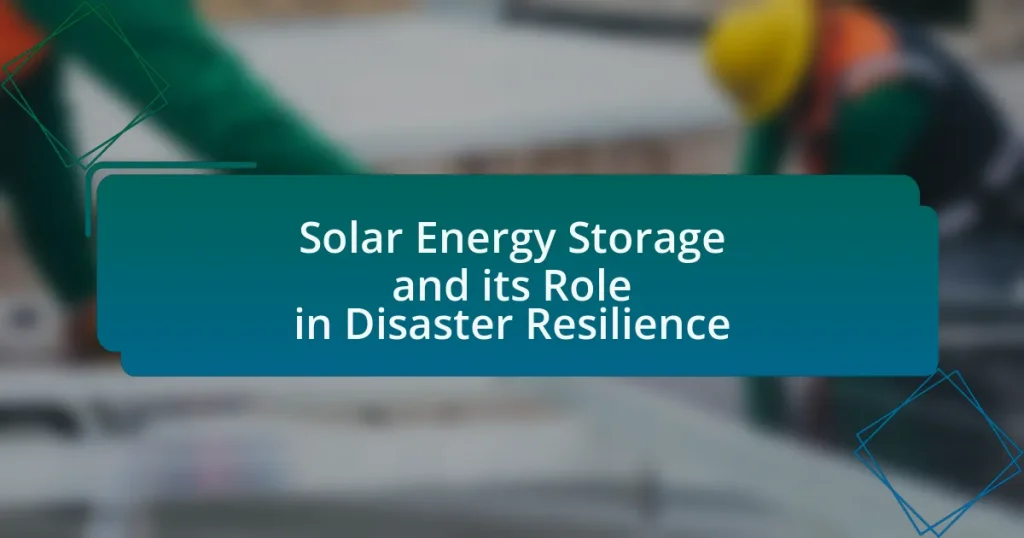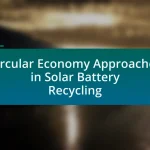Solar energy storage is a technology that captures and stores energy generated from solar panels for later use, playing a vital role in enhancing disaster resilience. This article explores how solar energy storage systems provide reliable power during emergencies, ensuring critical services remain operational when traditional energy grids fail. It discusses the technologies involved, such as lithium-ion and flow batteries, and highlights the immediate and long-term benefits of integrating solar energy storage into disaster preparedness plans. Additionally, the article addresses the challenges faced in implementing these systems, including economic factors and environmental impacts, while offering insights into best practices and successful case studies that demonstrate their effectiveness in disaster scenarios.
What is Solar Energy Storage and its Role in Disaster Resilience?
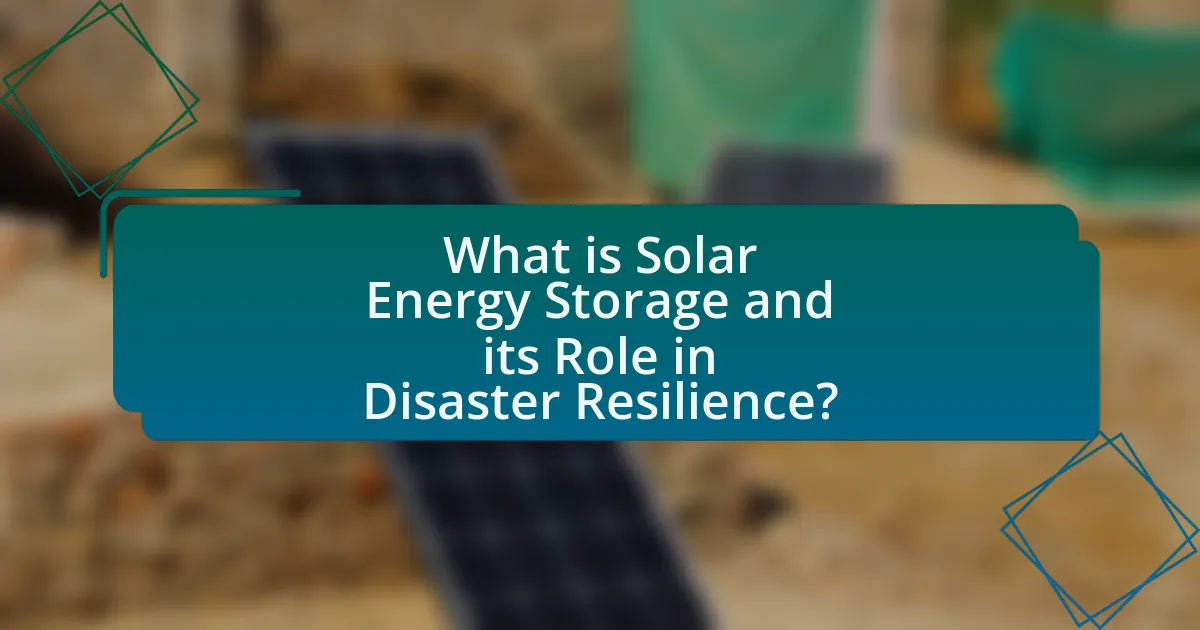

Solar energy storage refers to the technology that captures and stores energy generated from solar panels for later use. This stored energy plays a crucial role in disaster resilience by providing a reliable power source during emergencies when traditional energy grids may fail. For instance, during natural disasters like hurricanes or earthquakes, solar energy storage systems can ensure that critical services, such as hospitals and emergency response centers, maintain power, thereby enhancing community preparedness and recovery efforts. Studies have shown that integrating solar energy storage into disaster management plans significantly improves energy security and reduces reliance on fossil fuels, which can be disrupted during crises.
How does solar energy storage function in disaster scenarios?
Solar energy storage functions in disaster scenarios by providing a reliable power source when traditional electricity grids are compromised. During disasters, solar panels can generate electricity even in the absence of grid power, while battery storage systems store excess energy for use during outages. For instance, after Hurricane Maria in 2017, solar energy systems enabled some communities in Puerto Rico to maintain power, demonstrating the effectiveness of solar storage in crisis situations. This capability enhances resilience by ensuring access to electricity for essential services, communication, and emergency response efforts.
What technologies are used in solar energy storage systems?
Solar energy storage systems primarily utilize lithium-ion batteries, lead-acid batteries, flow batteries, and thermal energy storage technologies. Lithium-ion batteries are widely favored due to their high energy density and efficiency, making them suitable for residential and commercial applications. Lead-acid batteries, while older technology, are still used for their cost-effectiveness and reliability in off-grid systems. Flow batteries offer scalability and long-duration storage capabilities, ideal for larger installations. Thermal energy storage systems, such as molten salt, store heat generated from solar energy for later use, particularly in concentrated solar power plants. These technologies collectively enhance the reliability and efficiency of solar energy systems, contributing to energy resilience during disasters.
How do these technologies enhance disaster resilience?
Solar energy storage technologies enhance disaster resilience by providing reliable power during outages caused by natural disasters. These systems store excess solar energy generated during sunny periods, allowing communities to maintain electricity supply when the grid is compromised. For instance, during Hurricane Maria in Puerto Rico, solar energy storage systems enabled critical facilities, such as hospitals and emergency shelters, to operate independently of the damaged grid, demonstrating their effectiveness in maintaining essential services during crises.
Why is solar energy storage important for communities during disasters?
Solar energy storage is crucial for communities during disasters because it provides a reliable source of electricity when traditional power grids fail. In emergencies, such as hurricanes or earthquakes, power outages can last for days or weeks, disrupting essential services like healthcare, communication, and water supply. Solar energy storage systems, such as batteries, allow communities to harness and store solar power, ensuring access to electricity for critical needs. For instance, during Hurricane Sandy in 2012, areas with solar energy storage were able to maintain power for emergency services and shelters, demonstrating the effectiveness of this technology in enhancing disaster resilience.
What are the immediate benefits of solar energy storage in emergencies?
The immediate benefits of solar energy storage in emergencies include providing reliable power during outages and enhancing energy independence. Solar energy storage systems, such as batteries, can store excess energy generated during sunny periods, allowing households and businesses to access electricity when the grid is down. For instance, during Hurricane Sandy in 2012, areas with solar energy storage experienced fewer disruptions in power supply compared to those reliant solely on the grid. This capability not only ensures essential services can continue but also reduces reliance on fossil fuels, contributing to a more sustainable energy model during crises.
How does solar energy storage contribute to long-term recovery efforts?
Solar energy storage significantly enhances long-term recovery efforts by providing a reliable and sustainable power source during and after disasters. This technology allows communities to store excess solar energy generated during sunny periods, which can then be utilized when conventional power sources are disrupted or unavailable. For instance, after Hurricane Maria in Puerto Rico, solar energy storage systems enabled critical facilities, such as hospitals and emergency shelters, to maintain operations despite widespread power outages. Studies indicate that integrating solar energy storage into disaster recovery plans can reduce reliance on fossil fuels, lower energy costs, and improve energy security, thereby facilitating a more resilient infrastructure in the face of future disasters.
What are the challenges associated with solar energy storage in disaster resilience?
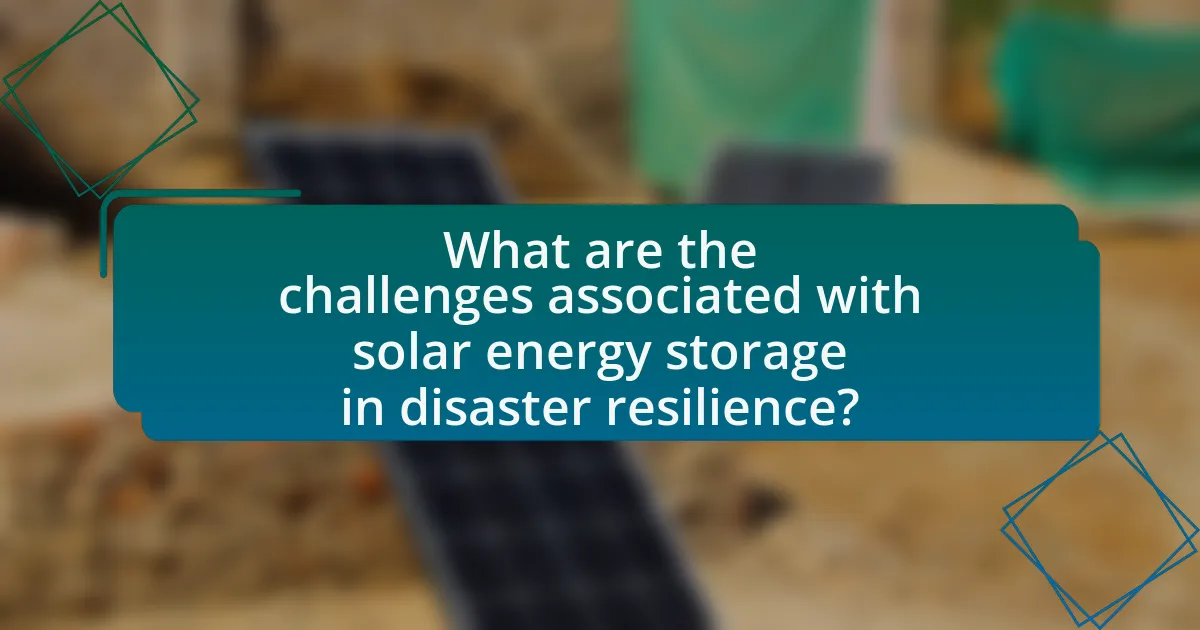

The challenges associated with solar energy storage in disaster resilience include limited storage capacity, high costs, and vulnerability to extreme weather events. Limited storage capacity restricts the amount of energy that can be stored for use during prolonged outages, which is critical in disaster scenarios. High costs of advanced battery technologies, such as lithium-ion batteries, can hinder widespread adoption, making it difficult for communities to invest in necessary infrastructure. Additionally, solar energy storage systems can be damaged or rendered ineffective by extreme weather conditions, such as hurricanes or floods, which can compromise their reliability when they are most needed. These factors collectively impact the effectiveness of solar energy storage in enhancing disaster resilience.
What limitations do solar energy storage systems face during disasters?
Solar energy storage systems face significant limitations during disasters, primarily due to their reliance on stable infrastructure and environmental conditions. These systems often require intact solar panels and operational batteries to function effectively; however, disasters such as hurricanes, floods, or earthquakes can damage these components, rendering them inoperable. For instance, a study by the National Renewable Energy Laboratory indicates that extreme weather events can lead to a 30-50% reduction in solar energy generation capacity due to physical damage and debris accumulation. Additionally, the energy storage capacity may be insufficient to meet emergency demands, as many systems are designed for regular use rather than prolonged outages, limiting their effectiveness in disaster scenarios.
How do environmental factors impact the effectiveness of solar energy storage?
Environmental factors significantly impact the effectiveness of solar energy storage by influencing both the efficiency of solar panels and the performance of storage systems. For instance, temperature variations can affect the efficiency of photovoltaic cells; higher temperatures typically reduce their output efficiency, while lower temperatures can enhance it. Additionally, humidity and dust accumulation can obstruct sunlight, leading to decreased energy capture.
Moreover, the design and materials of energy storage systems, such as batteries, can be affected by environmental conditions. Extreme temperatures can lead to reduced battery life and efficiency, as many batteries operate optimally within a specific temperature range. Research indicates that lithium-ion batteries, commonly used for solar energy storage, can experience a significant drop in performance when exposed to temperatures above 40 degrees Celsius or below 0 degrees Celsius.
Thus, environmental factors like temperature, humidity, and particulate matter directly influence the overall effectiveness of solar energy storage systems, impacting their reliability and efficiency in disaster resilience scenarios.
What are the economic challenges of implementing solar energy storage in disaster-prone areas?
The economic challenges of implementing solar energy storage in disaster-prone areas include high initial capital costs, maintenance expenses, and the need for robust infrastructure. High initial capital costs arise from the price of solar panels, batteries, and installation, which can be prohibitive for communities with limited budgets. Maintenance expenses are significant due to the harsh conditions often found in disaster-prone areas, leading to increased wear and tear on equipment. Additionally, the need for robust infrastructure to support solar energy systems can strain local economies, especially if existing facilities are inadequate or damaged. These factors collectively hinder the widespread adoption of solar energy storage solutions in such regions.
How can these challenges be addressed to improve disaster resilience?
To address challenges in disaster resilience, integrating solar energy storage systems can significantly enhance energy reliability during emergencies. These systems provide a decentralized power source, ensuring that critical infrastructure, such as hospitals and emergency services, remains operational when traditional power grids fail. For instance, during Hurricane Sandy in 2012, areas with solar energy storage experienced less disruption in power supply compared to those reliant solely on conventional energy sources. By investing in advanced battery technologies and incentivizing their adoption, communities can improve their preparedness and response capabilities in the face of disasters.
What innovations are being developed to enhance solar energy storage systems?
Innovations being developed to enhance solar energy storage systems include advanced battery technologies, such as solid-state batteries and flow batteries, which offer higher energy densities and longer lifespans. Solid-state batteries utilize solid electrolytes instead of liquid ones, improving safety and efficiency, while flow batteries allow for scalable energy storage by separating energy and power components. Additionally, research is focusing on integrating artificial intelligence for optimized energy management and predictive maintenance, which can significantly improve the performance and reliability of solar energy storage systems. These advancements are crucial for increasing the resilience of energy systems during disasters, as they enable more efficient energy use and storage, ensuring a reliable power supply when it is most needed.
How can policy changes support the integration of solar energy storage in disaster planning?
Policy changes can support the integration of solar energy storage in disaster planning by establishing regulatory frameworks that incentivize investment in solar technologies and storage systems. These frameworks can include tax credits, grants, and subsidies specifically aimed at enhancing the resilience of energy infrastructure during disasters. For instance, the Federal Emergency Management Agency (FEMA) has recognized the importance of renewable energy sources in disaster recovery, leading to policies that encourage the deployment of solar energy systems with storage capabilities in vulnerable communities. Such policies can facilitate the development of microgrids that operate independently during outages, ensuring continuous power supply for critical services.
What are the best practices for implementing solar energy storage in disaster resilience planning?
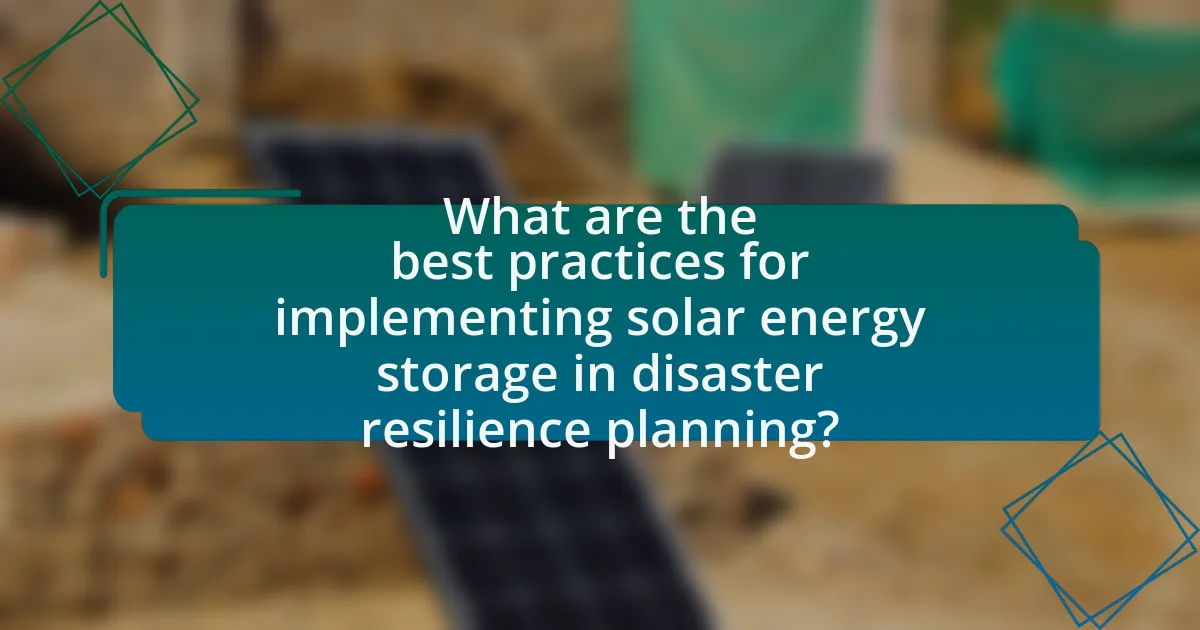

The best practices for implementing solar energy storage in disaster resilience planning include integrating energy storage systems with solar photovoltaic (PV) installations, ensuring redundancy and reliability, and conducting regular maintenance and testing. Integrating energy storage with solar PV allows for the capture and use of solar energy during outages, enhancing energy independence. Redundancy, such as having multiple storage units or backup generators, ensures that power remains available even if one system fails. Regular maintenance and testing of both solar and storage systems are crucial to ensure they function optimally during emergencies. These practices are supported by studies indicating that communities with robust solar energy storage systems can recover more quickly from disasters, as evidenced by the increased resilience observed in areas that adopted these technologies following events like hurricanes and wildfires.
How can communities effectively integrate solar energy storage into their disaster preparedness plans?
Communities can effectively integrate solar energy storage into their disaster preparedness plans by establishing a comprehensive framework that includes the installation of solar battery systems, training for local emergency responders, and creating partnerships with renewable energy organizations. This integration ensures that communities have access to reliable power during emergencies, as solar energy storage can provide backup electricity when traditional power sources are disrupted. For instance, a study by the National Renewable Energy Laboratory found that communities with solar-plus-storage systems can maintain critical services, such as hospitals and emergency shelters, during power outages. By incorporating solar energy storage into their disaster preparedness strategies, communities enhance their resilience and ability to respond to natural disasters.
What role do local governments play in promoting solar energy storage solutions?
Local governments play a crucial role in promoting solar energy storage solutions by implementing policies, providing incentives, and facilitating community engagement. They establish regulations that support the installation of solar energy systems and storage technologies, often offering tax credits or rebates to encourage adoption. For instance, cities like San Diego have adopted ambitious climate action plans that include specific targets for solar energy and storage deployment, demonstrating a commitment to renewable energy. Additionally, local governments can create partnerships with utility companies to develop programs that enhance grid resilience through energy storage, ensuring that communities can maintain power during emergencies. These actions not only promote the use of solar energy but also contribute to disaster resilience by providing reliable backup power sources.
How can public awareness campaigns enhance community engagement with solar energy storage?
Public awareness campaigns can enhance community engagement with solar energy storage by educating residents about its benefits and practical applications. These campaigns can provide information on how solar energy storage systems can improve energy resilience during disasters, reduce electricity costs, and contribute to environmental sustainability. For instance, studies show that communities with effective outreach programs see a 20% increase in solar adoption rates, indicating that informed residents are more likely to invest in solar technologies. By utilizing workshops, social media, and local events, these campaigns can foster a sense of community ownership and encourage collective action towards sustainable energy solutions.
What lessons have been learned from past disasters regarding solar energy storage?
Lessons learned from past disasters regarding solar energy storage include the importance of system resilience, the need for robust infrastructure, and the necessity of integrating energy storage with emergency response plans. For instance, Hurricane Sandy in 2012 highlighted vulnerabilities in energy systems, prompting the development of more resilient solar storage solutions that can withstand extreme weather. Additionally, the 2017 hurricanes in Puerto Rico demonstrated that decentralized solar energy systems with storage capabilities can provide critical power during prolonged outages, emphasizing the need for local energy independence. These events have led to improved designs and policies that prioritize durable materials and strategic planning for energy storage in disaster-prone areas.
What case studies illustrate successful solar energy storage implementations during disasters?
Successful solar energy storage implementations during disasters are illustrated by the case studies of Hurricane Maria in Puerto Rico and the 2020 California wildfires. In Puerto Rico, after Hurricane Maria devastated the island in 2017, solar microgrids with battery storage were deployed to restore power to critical facilities, such as hospitals and emergency shelters, demonstrating the effectiveness of solar energy in disaster recovery. Similarly, during the 2020 California wildfires, solar energy storage systems were utilized to provide backup power to homes and community centers, ensuring continuity of essential services amid widespread outages. These case studies highlight the resilience and reliability of solar energy storage in disaster scenarios, showcasing its ability to support recovery efforts and maintain essential services.
How can these lessons inform future disaster resilience strategies?
Lessons from solar energy storage systems can significantly enhance future disaster resilience strategies by demonstrating the importance of decentralized energy sources. These systems provide reliable power during outages, as evidenced by their performance during Hurricane Sandy in 2012, where solar energy storage enabled communities to maintain electricity when the grid failed. By integrating solar energy storage into disaster preparedness plans, communities can ensure energy independence, reduce reliance on vulnerable infrastructure, and improve recovery times after disasters. This approach aligns with findings from the National Renewable Energy Laboratory, which highlights that distributed energy resources can enhance grid resilience and support emergency response efforts.
What practical steps can individuals take to utilize solar energy storage for disaster preparedness?
Individuals can utilize solar energy storage for disaster preparedness by installing a solar power system with battery storage. This setup allows for the collection and storage of solar energy, ensuring a reliable power source during outages caused by disasters.
To implement this, individuals should first assess their energy needs and select an appropriate solar panel and battery system that can meet those requirements. Next, they should ensure proper installation by hiring certified professionals to maximize efficiency and safety. Regular maintenance of the solar panels and batteries is essential to ensure optimal performance, especially before anticipated disaster events.
Additionally, individuals can create an emergency plan that includes the use of stored solar energy for critical appliances, such as refrigerators, medical devices, and communication tools. This proactive approach enhances resilience against power disruptions during emergencies.
